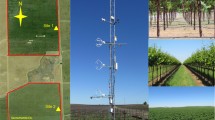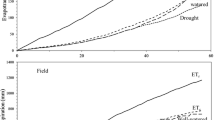Abstract
Upper and lower crop water stress index (CWSI) baselines adaptable to different environments and times of day are needed to facilitate irrigation scheduling with infrared thermometers. The objective of this study was to develop dynamic upper and lower CWSI baselines for corn and soybean. Ten-minute averages of canopy temperatures from corn and soybean plots at four levels of soil water depletion were measured at North Platte, Nebraska, during the 2004 growing season. Other variables such as solar radiation (R s), air temperature (T a), relative humidity (RH), wind speed (u), and plant canopy height (h) were also measured. Daily soil water depletions from the research plots were estimated using a soil water balance approach with a computer model that used soil, crop, weather, and irrigation data as input. Using this information, empirical equations to estimate the upper and lower CWSI baselines were developed for both crops. The lower baselines for both crops were functions of h, vapor pressure deficit (VPD), R s, and u. The upper baselines did not depend on VPD, but were a function of R s and u for soybean, and R s, h, and u for corn. By taking into account all the variables that significantly affected the baselines, it should be possible to apply them at different locations and times of day. The new baselines developed in this study should facilitate the application of the CWSI method as a practical tool for irrigation scheduling of corn and soybean.











Similar content being viewed by others
References
Allen RG, Pereira LS, Raes D, Smith M (1998) Crop evapotranspiration—guidelines for computing crop water requirements-FAO Irrigation and Drainage Paper No. 56. Rome, Italy: FAO
Alves I, Pereira LS (2000) Non-water-stressed baselines for irrigation scheduling with infrared thermometers: a new approach. Irrig Sci 19(2):101–106
Blad BL, Gardner BR, Watts DG, Rosenberg NJ (1981) Remote sensing of crop moisture status. Remote Sens Q 3:4–20
Bugbee B, Droter M, Monje O, Tanner B (1998) Evaluation and modification of commercial infra-red transducers for leaf temperature measurement. Adv Space Res 22(10):1425–1434
Carlson RE, Yarger DN, Shaw RH (1972) Environmental influences on the leaf temperatures of two soybean varieties grown under controlled irrigation. Agron J 64(2):224–229
Conaway J, van Bavel CHM (1967) Evaporation from a wet soil surface calculated from radiometrically determined surface temperatures. J Appl Meteorol 6(4):650–655
Ehrler WL (1973) Cotton leaf temperatures as related to soil water depletion and meteorological factors. Agron J 65(3):404–409
Ehrler WL, Idso SB, Jackson RD, Reginato RJ (1978) Wheat canopy temperature: relation to plant water potential. Agron J 70(2):251–256
Fuchs M, Tanner CB (1966) Infrared thermometry of vegetation. Agron J 58(6):597–601
Gates DM (1964) Leaf temperature and transpiration. Agron J 56(3):273–278
Geiser KM, Slack DC, Allred ER, Stange KW. 1982. Irrigation scheduling using crop canopy-air temperature difference. Trans ASAE 25(3):689–694
Idso SB. 1982. Non-water-stressed baselines: a key to measuring and interpreting crop water stress. Agric Meteorol 27(1):59–70
Idso SB, Jackson RD, Reginato RJ (1977) Remote sensing of crop yields. Science 196:19–25
Idso SB, Jackson RD, Pinter PJ, Hatfield JH (1981) Normalizing the stress-degree-day parameter for environmental variability. Agric Meteorol 24(1):45–55
Irmak S, Haman DZ, Bastug R (2000) Determination of crop water stress index for irrigation timing and yield estimation of corn. Agron J 92(6):1221–1227
Jackson RD (1982) Canopy temperature and crop water stress. In: Hillel D (ed) Advances in irrigation. Academic, New York, pp 43–85
Jackson RD, Reginato RJ, Idso SB (1977) Wheat canopy temperature: a practical tool for evaluating crop water requirements. Water Resour Res 13(3):651–656
Jackson RD, Idso SB, Reginato RJ, Pinter PJ (1981) Canopy temperature as a crop water stress indicator. Water Resour Res 17(4):1133–1138
Jensen HE, Svendsen H, Jensen SE, Mogensen VO (1990) Canopy-air temperature of crops grown under different irrigation regimes in a temperate humid climate. Irrig Sci 11:181–188
Johnson B (2001) Inventorying Nebraska’s irrigation acres. Cornhuskers Economics. University of Nebraska Cooperative Extension, June 20, 2 pp
Klocke NL, Watts DG, Schneekloth JP, Davison DR, Todd RW, Parkhurst AM (1999) Nitrate leaching in irrigated corn and soybean in a semi-arid climate. Trans ASAE 42(6):1621–1630
Linacre ET (1964) A note on a feature of leaf and air temperatures. Agric Meteorol 1(1):66–72
Nielsen DC, Gardner BR (1987) Scheduling irrigation for corn with the crop water stress index (CWSI). Appl Agric Res 2(5):295–300
Payero JO, Neale CMU, Wright JL (2004). Comparison of eleven vegetation indices for estimating plant height of alfalfa and grass. Appl Eng Agric 20(3):385–393
Payero JO, Neale CMU, Wright JL (2005a) Non-water-stressed baselines for calculating crop water stress index (CWSI) for alfalfa and tall fescue grass. Trans ASAE 48(2):653–661
Payero JO, Neale CMU, Wright JL (2005b) Estimating soil heat flux for alfalfa and clipped tall fescue grass. Appl Eng Agric 21(3):401–409
Payero JO, Neale CMU, Wright JL (2005c) Near-noon albedo values of alfalfa and tall fescue grass derived from multi-spectral data. Int J Remote Sens (in press)
Postel S (1999) Pillar of sand: can the irrigation miracle last?, 1st edn. W.W. Norton & Company, New York
Sadler EJ, Bauer PJ, Busscher WJ, Millen JA (2000) Site-specific analysis of a droughted corn crop: II. Water use and stress. Agron J 92(3):403–410
Shanahan JF, Nielsen DC (1987) Influence of growth retardants (Anti-Gibberellins) on corn vegetative growth, water use, and grain yield under different levels of water stress. Agron J 79(1):103–109
Stegman EC (1986) Efficient irrigation timing methods for corn production. Trans ASAE 29(1):203–210
Steele DD, Stegman EC, Gregor BL (1994) Field comparison of irrigation scheduling methods for corn. Trans ASAE 37(4):1197–1203
Wolpert A (1962) Heat transfer analysis of factors affecting plant leaf temperature: significance of leaf hair. Plant Physiol 37(2):113–120
Wright JL (1982) New evapotranspiration crop coefficients. J Irrig Drainage Div, ASCE 108:57–74
Yazar A, Howell TA, Dusek DA, Copeland KS (1999) Evaluation of crop water stress index for LEPA irrigated corn. Irrig Sci 18(4):171–180
Zolnier S, Gates RS, Anderson RG, Nokes SE, Duncan GA (2001) Non-water-stressed baseline as a tool for dynamic control of misting system for propagation of poinsettias. Trans ASAE 44(1):137–147
Acknowledgements
A contribution of the University of Nebraska Agricultural Research Division, Lincoln, NE 68583, Journal Series No. 15029. Partial funding for this project was provided by the USGS. Commercial names are provided only for the convenience of the reader and do not imply endorsement by the authors or by the University of Nebraska-Lincoln.
Author information
Authors and Affiliations
Corresponding author
Additional information
Communicated by S. Raine
Rights and permissions
About this article
Cite this article
Payero, J.O., Irmak, S. Variable upper and lower crop water stress index baselines for corn and soybean. Irrig Sci 25, 21–32 (2006). https://doi.org/10.1007/s00271-006-0031-2
Received:
Accepted:
Published:
Issue Date:
DOI: https://doi.org/10.1007/s00271-006-0031-2




